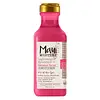What's inside
What's inside
 Key Ingredients
Key Ingredients

No key ingredients
 Benefits
Benefits

 Concerns
Concerns

 Ingredients Side-by-side
Ingredients Side-by-side

Aloe Barbadensis Leaf
MaskingWater
Skin ConditioningBehentrimonium Chloride
PreservativeCetearyl Alcohol
EmollientCetyl Alcohol
EmollientGlycerin
HumectantPPG-3 Benzyl Ether Myristate
EmollientSteareth-20
CleansingCocos Nucifera Water
MaskingHibiscus Abelmoschus Flower/Seed Water
MaskingPassiflora Incarnata Fruit Extract
Skin ConditioningCitrus Medica Vulgaris Fruit Extract
AntioxidantUndecane
EmollientPolyquaternium-47
Skin ConditioningTridecane
PerfumingPolyquaternium-37
Glycol Distearate
EmollientPropylene Glycol Dicaprylate/Dicaprate
EmollientPPG-1 Trideceth-6
Skin ConditioningIsopropyl Alcohol
SolventMaltodextrin
AbsorbentCitric Acid
BufferingSodium Hydroxide
BufferingSodium Benzoate
MaskingParfum
MaskingAloe Barbadensis Leaf, Water, Behentrimonium Chloride, Cetearyl Alcohol, Cetyl Alcohol, Glycerin, PPG-3 Benzyl Ether Myristate, Steareth-20, Cocos Nucifera Water, Hibiscus Abelmoschus Flower/Seed Water, Passiflora Incarnata Fruit Extract, Citrus Medica Vulgaris Fruit Extract, Undecane, Polyquaternium-47, Tridecane, Polyquaternium-37, Glycol Distearate, Propylene Glycol Dicaprylate/Dicaprate, PPG-1 Trideceth-6, Isopropyl Alcohol, Maltodextrin, Citric Acid, Sodium Hydroxide, Sodium Benzoate, Parfum
Water
Skin ConditioningSodium Cocoyl Isethionate
CleansingLauramidopropyl Betaine
CleansingCocamidopropyl Betaine
CleansingSodium Lauroyl Sarcosinate
CleansingParfum
MaskingAloe Barbadensis Leaf Juice
Skin ConditioningEucalyptus Globulus Leaf Extract
PerfumingHistidine
HumectantMentha Piperita Oil
MaskingMentha Arvensis Leaf Oil
MaskingSodium Benzoate
MaskingSodium Salicylate
PreservativeMenthol
MaskingPolyquaternium-10
Sodium Citrate
BufferingCitric Acid
BufferingTetrasodium EDTA
Water, Sodium Cocoyl Isethionate, Lauramidopropyl Betaine, Cocamidopropyl Betaine, Sodium Lauroyl Sarcosinate, Parfum, Aloe Barbadensis Leaf Juice, Eucalyptus Globulus Leaf Extract, Histidine, Mentha Piperita Oil, Mentha Arvensis Leaf Oil, Sodium Benzoate, Sodium Salicylate, Menthol, Polyquaternium-10, Sodium Citrate, Citric Acid, Tetrasodium EDTA
Ingredients Explained
These ingredients are found in both products.
Ingredients higher up in an ingredient list are typically present in a larger amount.
Citric Acid is an alpha hydroxy acid (AHA) naturally found in citrus fruits like oranges, lemons, and limes.
Like other AHAs, citric acid can exfoliate skin by breaking down the bonds that hold dead skin cells together. This helps reveal smoother and brighter skin underneath.
However, this exfoliating effect only happens at high concentrations (20%) which can be hard to find in cosmetic products.
Due to this, citric acid is usually included in small amounts as a pH adjuster. This helps keep products slightly more acidic and compatible with skin's natural pH.
In skincare formulas, citric acid can:
While it can provide some skin benefits, research shows lactic acid and glycolic acid are generally more effective and less irritating exfoliants.
Most citric acid used in skincare today is made by fermenting sugars (usually from molasses). This synthetic version is identical to the natural citrus form but easier to stabilize and use in formulations.
Read more about some other popular AHA's here:
Learn more about Citric AcidParfum is a catch-all term for an ingredient or more that is used to give a scent to products.
Also called "fragrance", this ingredient can be a blend of hundreds of chemicals or plant oils. This means every product with "fragrance" or "parfum" in the ingredients list is a different mixture.
For instance, Habanolide is a proprietary trade name for a specific aroma chemical. When used as a fragrance ingredient in cosmetics, most aroma chemicals fall under the broad labeling category of “FRAGRANCE” or “PARFUM” according to EU and US regulations.
The term 'parfum' or 'fragrance' is not regulated in many countries. In many cases, it is up to the brand to define this term.
For instance, many brands choose to label themselves as "fragrance-free" because they are not using synthetic fragrances. However, their products may still contain ingredients such as essential oils that are considered a fragrance by INCI standards.
One example is Calendula flower extract. Calendula is an essential oil that still imparts a scent or 'fragrance'.
Depending on the blend, the ingredients in the mixture can cause allergies and sensitivities on the skin. Some ingredients that are known EU allergens include linalool and citronellol.
Parfum can also be used to mask or cover an unpleasant scent.
The bottom line is: not all fragrances/parfum/ingredients are created equally. If you are worried about fragrances, we recommend taking a closer look at an ingredient. And of course, we always recommend speaking with a professional.
Learn more about ParfumSodium Benzoate is a preservative. It's used in both cosmetic and food products to inhibit the growth of mold and bacteria. It is typically produced synthetically.
Both the US FDA and EU Health Committee have approved the use of sodium benzoate. In the US, levels of 0.1% (of the total product) are allowed.
Sodium benzoate works as a preservative by inhibiting the growth of bacteria inside of cells. It prevents the cell from fermenting a type of sugar using an enzyme called phosphofructokinase.
It is the salt of benzoic acid. Foods containing sodium benzoate include soda, salad dressings, condiments, fruit juices, wines, and snack foods.
Studies for using ascorbic acid and sodium benzoate in cosmetics are lacking, especially in skincare routines with multiple steps.
We always recommend speaking with a professional, such as a dermatologist, if you have any concerns.
Learn more about Sodium BenzoateWater. It's the most common cosmetic ingredient of all. You'll usually see it at the top of ingredient lists, meaning that it makes up the largest part of the product.
So why is it so popular? Water most often acts as a solvent - this means that it helps dissolve other ingredients into the formulation.
You'll also recognize water as that liquid we all need to stay alive. If you see this, drink a glass of water. Stay hydrated!
Learn more about Water